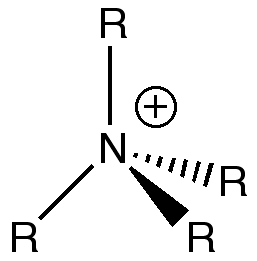Ionic Liquids: Designer Solvents
Ionic liquids are room temperature liquids, or low melting point solids, composed solely of ions. They form an exciting new class of materials with interesting properties and a diverse range of applications. Given the high melting points of typical ionic salts (i.e. NaCl has a melting point of ~ 801°C), it is remarkable that we can obtain liquid salts at room temperature. However, this can be readily achieved through careful selection and modulation of the constituent ions. Typically, ionic liquids are composed of bulky and charge delocalised, asymmetric organic cations and inorganic anions. Some examples of common cations and anions are provided in the figure below.

In theory, the cation and anion combination can be carefully engineered to give an ionic liquid with the desired properties for a specified purpose. This has resulted in ionic liquids being termed "designer solvents". Given the huge range of possible combinations of ions it is impossible to experimentally synthesise and determine the physical and chemical properties of them all. Increasingly, computational chemistry has become an important tool in helping us to understand ionic liquids at the molecular level. Significantly, we may soon begin to be able to use computational chemistry to predict the properties of ionic liquids before they are made. In this mini-project you will use the analysis techniques you have learnt to investigate selected properties of a number of related cations.
Important For the projects just presenting information is not sufficient,you must interpret your results. (After all this is the key component in all research projects!). The calculations for this project are straight forward, and thus most of the assigned marks are for interpretation.
Part 1: Comparison of selected 'onium' cations
- Use the full basis set 6-31G(d,p) on all atoms
- optimise, and carry out a frequency analysis to confirm you have a minima for each of the following cations
- [N(CH3)4]+
- [P(CH3)4]+
- [S(CH3)3]+
- Don't forget to apply the correct charge! This is set on the methods window and was discussed in the "using a better basis set" section. An incorrect charge will mean your results are useless!
- note that you may get formally zero frequencies of ± 20-30 cm-1. This occurs because the basis set we are using is not quite good enough and there are some very soft vibrational modes.
- Comment on the geometries with respect to the central heteroatom. "Comment on geometries" means examining not just the overall structure but also key bond distances and angles across the series of structures. Then because this is a project you need to rationalise or interpret these results.
- Carry out a MO and NBO calcualtion for each structure.
- visualise all the occupied non-core MOs of [N(CH3)4]+, you do not need to reproduce them all. A problem from previous groups has been in distingishing between core and non-core orbitals, if you don't know the difference please ask a demonstrator for help.
- in your wiki present 5 MOs (from [N(CH3)4]+) ranging from highly bonding to highly antibonding (from any of the MOs you have visualised) and describe the interactions occuring in the MOs. Please be detailed, vaugue references such as saying there are "through space" interactions is not sufficient. You can annotate your orbital pictures in chem-draw. Things you might want to consider are:
- Are AO interactions strong or weak?
- Are AO interactions bonding or antibonding?
- Are there through space interactions?
- How many and what kinds of nodes are there?
- How delocalised is the MO?
- Using the NBO charge analysis compare and contrast the charge distribution across this trio of cations. How can your results be rationalised?
- reminder: NBO charges not Mulliken!
- charges should be tabulated, it is difficult to compare charges visually via the images.
- however images are useful in a qualitative way and when you include images of the charge ensure your charge range is the same accross all the images. This can be set by manually altering the range on the charge bar. Ask a demonstrator if you need help!
- Using the NBO population analysis compare and contrast the relative contribution of the C and heteroatom to the C-X bond. How do your results relate to the charge distribution just studied?
-
 [NR4]+ (R=alkyl) is often depicted as shown, with the positive charge placed on the nitrogen centre. Based on your results for [N(CH3)4]+, discuss the validity of the traditional description. You should consider the following:
[NR4]+ (R=alkyl) is often depicted as shown, with the positive charge placed on the nitrogen centre. Based on your results for [N(CH3)4]+, discuss the validity of the traditional description. You should consider the following:
- What does the "formal" positive charge on the N represent in the traditional picture?
- On what atoms is the positive charge actually located for this cation?
Part 2: Influence of functional groups
- optimise, and carry out a frequency analysis to confirm you have a minima for each of the following cations:
- [N(CH3)3(CH2OH)]+
- [N(CH3)3(CH2CN)]+
- Carry out an MO and NBO calculation for each structure.
- OH is an electron donating group and CN is an electron withdrawing group, what effect have these groups had on the charge distribution?
- Compare and contrast the HOMO and LUMO of [N(CH3)4]+, [N(CH3)3(CH2OH)]+ and [N(CH3)3(CH2CN)]+
- how has the shape of the orbitals changed?
- has the energy of these orbitals moved?
- has the HOMO-LUMO gap changed in size?
- what chemical impact could these changes have?
- optional Comment on or analyse or describe some aspect of these systems which you found interesting.
